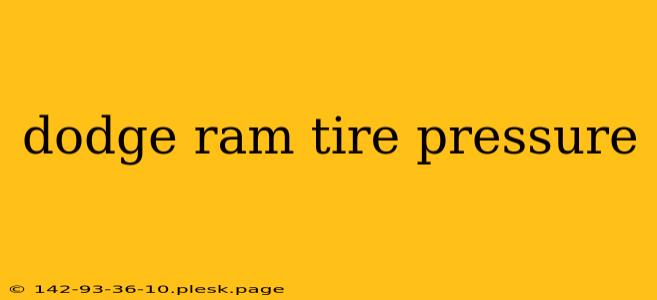Maintaining the correct tire pressure in your Dodge Ram is crucial for safety, fuel efficiency, and tire longevity. Ignoring this simple yet vital aspect of vehicle maintenance can lead to dangerous situations and costly repairs. This guide provides a comprehensive overview of Dodge Ram tire pressure, covering everything from finding the recommended pressure to understanding the impact of incorrect inflation.
Finding Your Dodge Ram's Recommended Tire Pressure
The most accurate source for your Dodge Ram's recommended tire pressure is the sticker located on the driver's side doorjamb. This sticker specifies the recommended tire pressure for both the front and rear tires, often indicating different pressures depending on the load. Pay close attention to this sticker; it's your primary reference point.
This sticker usually provides two numbers: one for normal driving conditions and another for heavier loads. The number for heavier loads will be higher. If you frequently carry heavy cargo or tow a trailer, use the higher pressure.
Understanding Tire Pressure Units
Tire pressure is typically measured in PSI (pounds per square inch). Never confuse PSI with other units. Make sure your tire gauge measures in PSI to get accurate readings.
Checking Your Tire Pressure
Checking your tire pressure is a simple process that should be performed regularly, ideally once a month or before long trips. Here's how:
-
Cold Tires: Check your tire pressure when the tires are cold. This means the vehicle hasn't been driven for at least three hours. Driving warms the tires, which increases the pressure reading.
-
Use a Reliable Gauge: Invest in a quality tire pressure gauge. Inaccurate gauges can lead to incorrect inflation.
-
Locate the Valve Stem: This is the small metal stem protruding from your tire.
-
Attach the Gauge: Press the gauge firmly onto the valve stem. You should hear a hiss of air as the gauge reads the pressure.
-
Compare to Recommended Pressure: Compare the gauge reading to the recommended pressure on your driver's side doorjamb sticker.
-
Adjust as Needed: If the pressure is too low, add air using a compressed air source at a gas station or other convenient location. If the pressure is too high, carefully release air using the valve stem.
The Consequences of Incorrect Tire Pressure
Maintaining the correct tire pressure is not merely a suggestion; it's crucial for several reasons:
Safety
- Reduced Traction: Underinflated tires reduce the contact patch between the tire and the road, leading to decreased traction, especially in wet or icy conditions. This can increase the risk of accidents.
- Uneven Wear: Incorrect tire pressure can cause uneven tire wear, shortening their lifespan and potentially leading to tire failure.
Fuel Efficiency
Underinflated tires increase rolling resistance, which means your engine has to work harder, leading to reduced fuel economy.
Tire Longevity
Proper inflation significantly extends the life of your tires. Consistent underinflation can lead to premature wear and tear, necessitating more frequent tire replacements.
Conclusion
Regularly checking and maintaining the correct tire pressure in your Dodge Ram is an essential part of responsible vehicle ownership. By following the guidelines outlined in this guide, you can ensure the safety, fuel efficiency, and longevity of your vehicle. Remember to always consult the sticker on your driver's side doorjamb for the most accurate recommended tire pressure for your specific Dodge Ram model and load conditions.

